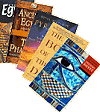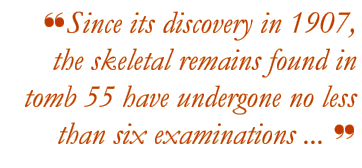|
|
||||||||||||||||||
|
|
Pages in this article: the discovery | the coffin | the physical remains | further examinations | reconstructions and conclusions The physical remains
The first "examination" was carried out by the local European physician at Luxor, and a prominent American obstetrician named Dr Pollock, holidaying at Thebes. The doctors had the unenviable task of basing their findings on a body that was in a very poor state of preservation, whilst still in situ.
Davis described the remains as those of a "smallish person, with a delicate head and hands." [16] The remains were in such a fragile condition that Davis reported that "a tooth crumbled when he touched it," [17] he also noted that the head was detached from the body. An interesting aside concerning the decapitation of the head. We have seen how Nicholas Reeves postulates how this happened; Gaston Maspero formulates a less dramatic scenario, saying "He had found a stone inside the coffin and believed this had separated the head of the mummy from the body when it had fallen from the ceiling" [18]
In July of 1907 the "body" was sent, along with its wrappings to Grafton Elliot Smith, the Professor of Anatomy in the Cairo School of Medicine for a more detailed examination of the remains. On completion of his examination Smith concluded that the individual was a male whose pelvic arch measurement was 67°, well within the medical standard for a male of 70-75°, whilst the female pelvis angle measures some 90° - 100°, thus the pelvis is "ultra male". Smith also determined the age using certain criteria, namely the epiphyseal union of the scapula, clavicles and hip bones and deduced that the individual was probably more than 23 and no more than 25 years of age [19] Why the confusion?
To substantiate his claim, Smith stated that the smashed skull of the individual exhibited chronic hydrocephalus, an enlarged cranium. Smith's findings are somewhat puzzling. If it was Akhenaten, Smith was unable to detect in the skeleton any pronounced anatomical peculiarities that could reconcile the peculiar representations of Akhenaten. Moreover, the low age of the individual made it practically impossible for the body to be that of Akhenaten, whose estimated age at death was at least 30 to 35 years old. It would appear that Smith's examination had been influenced by the fact that various items in the burial contained Akhenaten's name or titles.
|
|||||||||||||||||

|
||||||||||||||||||
|
||||||||||||||||||






 Weigall noted that both the head and feet of the mummy were exposed when the excavators first entered KV55, and stated that the bandages which had once covered them had "decayed and fallen off." He continued, saying "the bare skull ... could be seen protruding from the remains of the linen bandages and from the sheets of flexible gold foil in which ... the whole body was wrapped." [15]
Weigall noted that both the head and feet of the mummy were exposed when the excavators first entered KV55, and stated that the bandages which had once covered them had "decayed and fallen off." He continued, saying "the bare skull ... could be seen protruding from the remains of the linen bandages and from the sheets of flexible gold foil in which ... the whole body was wrapped." [15] The criteria that the two doctors used for sexing the remains was the pelvis, as it allows the most easily appreciable contrast between male and female. On examination of the pelvic area both doctors instantly agreed that the remains were those of a woman, vindicating Davis's assumption that he had discovered the tomb of queen Tiye, which he subsequently published as such in 1910.
The criteria that the two doctors used for sexing the remains was the pelvis, as it allows the most easily appreciable contrast between male and female. On examination of the pelvic area both doctors instantly agreed that the remains were those of a woman, vindicating Davis's assumption that he had discovered the tomb of queen Tiye, which he subsequently published as such in 1910.